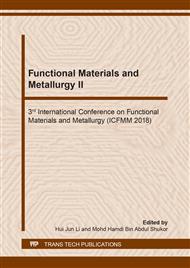[1]
A. Azdarpour, M. Asadullah, R. Junin, M. Manan, H. Hamidi, and E. Mohammadian (2014). Direct carbonation of red gypsum to produce solid carbonates. Fuel Process. Technol., 126, 429434.
DOI: 10.1016/j.fuproc.2014.05.028
Google Scholar
[2]
Z.M. Safuan, S. Hassan, and M. Faizairi (2014). Thermal Drying of Malaysian Sewage Sludge. J. of Adv. Res. in Fluid Mechanics and Thermal Sciences 3(1), 1-5.
Google Scholar
[3]
A.G. Liew, A. Idris, C.H. Wong, A.A. Samad, M.J.M. Noor and A.M. Baki (2004). Incorporation of sewage sludge in clay brick and its characterization. Waste Manage. Res., 22(4), 226-233.
DOI: 10.1177/0734242x04044989
Google Scholar
[4]
C.I. Fauziah, M.N. Hanani, S. Zauyah, A.W. Samsuri, and A. Rosazlin (2011). Coapplication of Red Gypsum and Sewage Sludge on Acidic Tropical Soils. Commun. Soil Sci. Plant Anal., 42(21), 25612571.
DOI: 10.1080/00103624.2011.614032
Google Scholar
[5]
P.N. Hughes, S. Glendinning, D.A.C. Manning and B.C. Noble (2010, September). Production of green,concrete using red gypsum and waste. In Proc. of the Institution of Civil Engineers-Engineering Sustainability, 163(3), 137-146, Thomas Telford Ltd.
DOI: 10.1680/ensu.2010.163.3.137
Google Scholar
[6]
I. Fauziah, S. Zauyah, and T. Jamal (1996). Characterization and land application of red gypsum: a waste product from the titanium dioxide industry. Sci. Total Environ. 188(2), 243251.
DOI: 10.1016/0048-9697(96)05179-0
Google Scholar
[7]
L. Bonfiglioli, A. Bianchini, M. Pellegrini and C. Saccani, C (2014). Sewage sludge: characteristics and recovery options, AMS Acta [Preprint].
Google Scholar
[8]
J. Liu, J. Chen, Z. He and G. Zhang (2011). Study on performance of concrete made from sewage sludge ceramsite. Open Materials Science Journal, 5, 123-129.
DOI: 10.2174/1874088x01105010123
Google Scholar
[9]
B.M. Ghodki and T.K. Goswami (2016). Effect of grinding temperatures on particle and physicochemical characteristics of black pepper powder. Powder Technol., 299, 168-177.
DOI: 10.1016/j.powtec.2016.05.042
Google Scholar
[10]
P.N. Hughes and S. Glendinning (2005). Development of a soil mixing binder using waste materials. In 1st International Conference on Engineering for Waste Treatment: Beneficial Use of Waste and By-Products (Waste Eng 2005), Albi, France.
Google Scholar
[11]
M.J. Gázquez, J.P. Bolívar, R. García-Tenorio and F. Vaca (2009). Physicochemical characterization of raw materials and co-products from the titanium dioxide industry. J. Hazard. Mater., 166(2), 1429-1440.
DOI: 10.1016/j.jhazmat.2008.12.067
Google Scholar
[12]
Y.L. Li, J.W. Liu, J.Y. Chen, Y.F. Shi, W. Mao, H. Liu and J.K. Yang (2014). Reuse of dewatered sewage sludge conditioned with skeleton builders as landfill cover material. Int. J. Environ. Sci. Technol., 11(1), 233-240.
DOI: 10.1007/s13762-013-0199-y
Google Scholar
[13]
P. Chen, L. Zhan and W. Wilson (2014). Experimental investigation on shear strength and permeability of a deeply dewatered sewage sludge for use in landfill covers. Environmental Earth Sciences, 71(10), 4593-4602.
DOI: 10.1007/s12665-013-2851-8
Google Scholar


